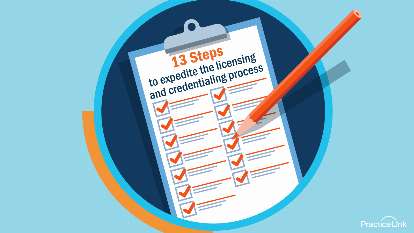
Licensing and credentialing conversations can be the most challenging to navigate for both candidates and recruiters. For the best results as you approach this step of recruitment, take note of recent changes caused by the pandemic and brush up on these best practices:
Review the basics
Before starting work, physicians must provide documents and complete forms that rival daily electronic medical record documentation. It’s a good idea to remind yourself of the following common areas that include vital elements for employment credentials and hospital privileges:
Basic demographic information
This will include the candidate’s full name, address, birthdate, contact details, social security, Drug Enforcement Agency registration numbers, National Practitioner Identifier numbers, etc. To be acted on, this phase of assessing credentials will require primary source verifications. Some organizations will go back five years, while others will go back 10.
Work education and training details
Candidates will provide copies of their medical school diploma, internship/residency completion documentation, and details relating to previous employers and hospitals where they’ve held staff privileges.
Legal information
Implications for malpractice or licensing issues will also be assessed. When prompted with questions about board sanctions, a host of other documents will be required if your candidate answers "yes" to any of them. Here, you’ll be able to ensure your candidate doesn’t have any outstanding malpractice actions or suits.
Peer references
Candidates will probably provide contact information for peer references. Make a point to look into a physician’s references, but also consider reaching out to nurses, administrators and other staff who may have worked closely with your prospect.
Competency Documentation
Many health systems ask potential hires for proof of competency. This may be as simple as requesting the number of procedures performed in the last few years to ensure they’ve been actively in practice. Case logs can be helpful in assessing this and may require a direct request of this information from your new hire.
Credentialing standards are set by the National Committee on Quality Assurance, and specific state and federal regulations for participation in the Medicaid and Medicare programs.

Know your state’s current requirements
Over the past several months, the federal and many state governments have eased regulations on licensing and credentialing in order to allow physicians and other qualified health care professionals to work across state lines during the public health emergency. While actions differ by state, some have shortened the application process and expedited the approval process to help health workers provide care to their communities as soon as possible.
The Centers for Medicare and Medicaid Services has also approved telehealth services across state lines, as long as it’s provided by a licensed physician. However, providers coming out of retirement to aid pandemic efforts still need to complete the provisional credentialing process before practicing.
You’ll want to be familiar with updates to federal and local licensing and credentialing requirements so you can best anticipate what this phase will look like. Click here for more information about federal and state guidelines.
Know your team - and your role
Be ready for questions from candidates about the type of assistance they can expect to receive while working to obtain their license and credentials. They may ask if your health system has an in-house licensing team to help coordinate primary source credential verification, and whether your facility covers the cost of acquisition.
Make sure you know who in your organization is responsible for keeping track of the credentials for every employed physician at your facility, and also for guiding new physicians through the process’s logistics. Clarity on this can help you determine what your specific responsibilities are, and how closely you should be overseeing each step.
Mind the gap
You may still be waiting for some of your candidate’s credentials to be verified even after you’ve hired them. During this gap, you’ll need to consider whether you’ll allow your physician to start practicing and what kind of liability is involved.
For example, it usually takes Ambulatory Surgery Centers 60 to 90 days to collect all required credentialing materials. Although temporary permission can be provided to allow surgeons to perform cases, Becker’s Ambulatory Surgery Centers Review advises background checks first to ensure they don’t "have a higher number of adverse events that could put the center at risk."
Timeliness is always a recruiter’s priority, but it shouldn’t replace thoughtful consideration of whether allowing a physician to temporarily practice without credentials could end up hurting more than helping your organization.
Gauge timing of the process
The time it takes to obtain medical credentials can depend on how long it takes for insurance companies to receive a candidate’s applications, the current influx of applications received, how long primary verifications take and more. Completing applications alone can sometimes take hours or days, while the entire process can sometimes last months depending on the candidate.
However, right now many of the process’s steps are being accelerated to help health workers receive their credentials faster and provide immediate COVID relief where it’s needed. While beneficial, it’s still unclear exactly how long the process will take, so basic trends prior to the pandemic can help make predictions.
A general rule of thumb is the more seasoned a physician, the longer their credentialing process; more history and experience equals more verification. Foreign medical graduates wanting to practice in the U.S. will also have a longer process for getting immigration and international qualifications approved.
Alternatively, physicians just out of residency have less history and training to verify, often making their wait times and applications much shorter.

Reduce delays on your end
The licensing and credentialing process can be lengthy as it is; the last thing you want is to be the one holding up the process. Here are a few simple ways to avoid delays on your end:
Guide your new hire
While licensing and credentialing conversations may be familiar to you, keep in mind it’s not a one-size-fits-all process. The amount of guidance you give throughout these phases of recruitment depends entirely on the individual.
For example, a new hire with 20 plus years of experience will probably be more familiar (and need less assistance) navigating the topic than a physician fresh out of residency. However, you don’t want to make assumptions about one’s needs solely based on their years of experience in the field.
Regardless of how much guidance you think will be needed, make yourself available. Transparency on your side of the process is extremely valuable to your recruits and ensures them you’ll be doing your best to get them into practice as quickly and efficiently as possible.

Alexandra Cappetta